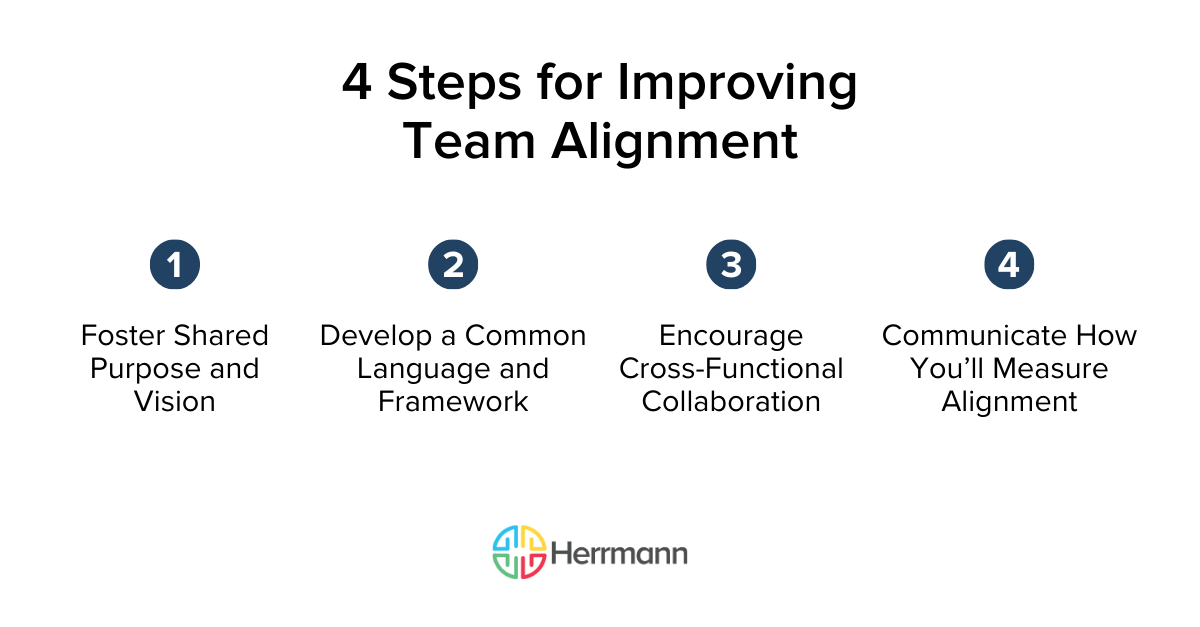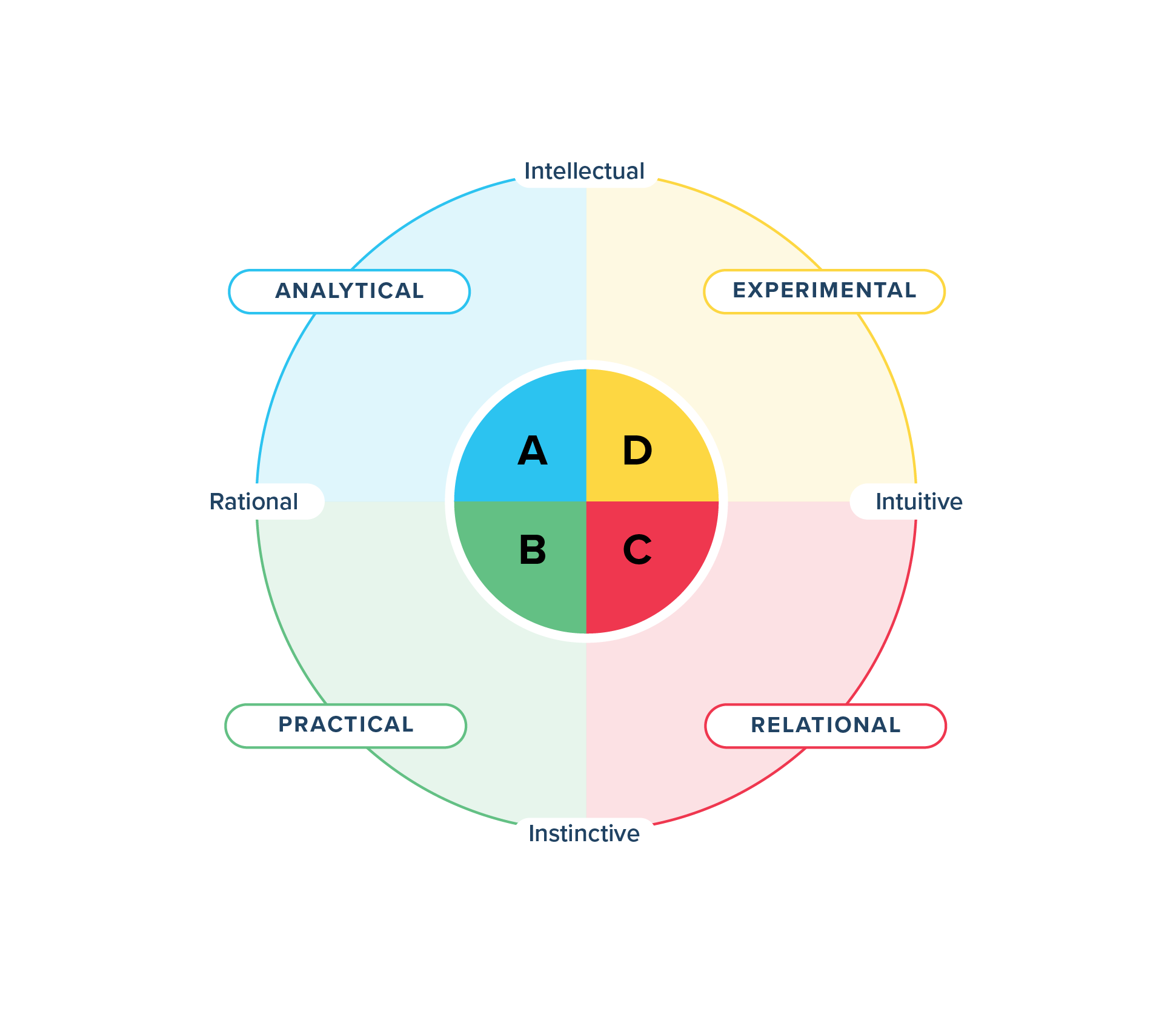Every organization wants to be efficient, effective, and focused. However, the best leaders don’t want groupthink; they want team alignment, in which employees coordinate their actions toward individual, team, and organizational goals.
Assessing that alignment quickly becomes complex in larger organizations because it must accurately reflect each employee’s perception of their alignment with their co-workers’ and company’s goals. And people’s perceptions and reality are often, well, not aligned. For example, 82% of surveyed employees believe their organization is strategically aligned, according to research highlighted in Harvard Business Review. But actual alignment, as measured by written responses, was only 23% — nearly 60 percentage points lower!
When a team isn’t aligned — or worse, when its members mistakenly believe they are aligned — employees face more conflict, lower productivity, and reduced confidence in leadership, among other drawbacks.
Learn more about what “alignment” means, the importance of team alignment in the workplace, and how team leaders can actually get their employees on the same page.
What Is Team Alignment at Work?
Team alignment reflects a state in which team members share a common understanding of goals, objectives, and strategies. They generally work cohesively to pursue these goals and overcome obstacles.
When a team is aligned, there’s a sense of unity, collaboration, and shared purpose. Individuals know how their contributions complement other people’s activity within the team, including across job roles and duties.
Common Benefits of Strongly Aligned Teams
Team alignment isn’t just nice to have or a way to stay organized. Aligned teams often work better and smarter — and they can communicate and collaborate more effectively to solve problems and reimagine the future. Here are some of the high-level benefits of fostering team alignment.
Stronger Business Performance
Research, including from HubSpot, has shown how sales and marketing alignment contributes to more closed deals and higher revenue and profit than poorly aligned teams. Team alignment can impact business performance even if team members are not in a revenue-facing function. They can increase collaboration, reduce duplicative or conflicting work, and improve the likelihood of innovation.
Increased Employee Engagement and Morale
Aligned teams find it easier to discover purpose and meaning in their work. This can contribute to higher employee engagement — and a more productive use of existing engagement and enthusiasm. For example, a customer-facing employee might be highly engaged, but if they’re misaligned on the product strategy or customer services best practices, they might deliver a negative customer experience.
Alignment contributes to a positive work environment, higher morale, and a stronger sense of camaraderie among team members. Because team members feel in sync rather than disconnected or at odds, they feel more positive about coming to work and the organization’s direction.
Improved Communication and Collaboration
Strong alignment facilitates effective communication within the team because everyone understands their role and responsibilities. Teammates can easily share information, ideas, and feedback for better collaboration and problem-solving. Alignment reduces misunderstandings and conflicts. Teams are less likely to perform duplicative work or spend their time on irrelevant business activities.
Increased Efficiency and Productivity
Aligned teams work cohesively toward common goals, reducing redundant or conflicting efforts. Clear alignment enables teams to streamline processes, optimize workflows, and eliminate bottlenecks.
With a shared understanding of priorities and objectives, team members can focus their efforts on tasks that most contribute to the team's success. Perhaps most importantly, every employee understands their responsibilities and is accountable for them. Teams avoid situations in which a few employees bear the burden of success — and suffer from overwork, stress, and resentment toward their colleagues.
Improved Decision-Making
Alignment promotes a shared understanding of the team's goals and objectives for decision-making. This alignment often extends to the information available to decision-makers. When leaders operate on the same data, business intelligence, and goals, they can have transparent conversations about the potential decisions in front of them. While the group might have differing opinions, its members can discuss them using the same information. And they’re more likely to make the best choice for the business in a timely manner.
How to Assess Team Alignment
Before team leaders can fix misalignments, they need to understand where their team stands. Whether that alignment is good or poor, they can use this baseline to get started. Here are some ways to assess team alignment, either directly or indirectly.
Surveys and Assessments
Surveys and assessments provide a structured approach to gather quantitative and qualitative data on team alignment. Employee engagement questions can offer insight into alignment, particularly if organizations ask whether employees feel they understand organizational goals, believe communication is strong, or trust their co-workers. By analyzing survey responses, team leaders can identify patterns, trends, and areas of misalignment within the team.
Alignment assessments are formal exercises, often conducted by HR, that can use a variety of tools to figure out whether teams are aligned. Organizations should make sure they define what the assessment is measuring (overall alignment or just alignment on strategy, for example), who will participate, and what they hope to do with the assessment results.
Interviews and Focus Groups
Interviews and focus groups are conversations with team members that explore how they perceive organizational alignment, including the experiences they’ve had. While these interviews should follow a consistent process, the questions also should allow for open-ended answers in which team members can express their thoughts and concerns.
These qualitative approaches provide rich data that complements the quantitative data obtained from surveys, performance data, and other sources.
Performance Metrics and KPIs
Performance metrics and key performance indicators (KPIs) can be an indirect way of measuring team alignment in an objective way. By tracking metrics related to team goals, productivity, work quality, or customer satisfaction, team leaders can look for patterns that point to changes in alignment.
For example, if a customer service team is trying to increase customer satisfaction rates, metrics such as customer feedback scores or repeat business rates can show whether it’s succeeding. That data can be compared against past performance or recent process changes. For example, if a team leader notices an increase in customer satisfaction after updating their training programs, they might reasonably conclude that the training improved team alignment and knowledge.
Feedback From Outside Stakeholders
Team leaders should ensure that they gather feedback from outside the team, such as other employees who work closely with the group, as well as customers, suppliers, and partners. They can offer a distinct view of a team's performance, including their perceptions of whether the employees are in alignment. Such feedback can be collected through surveys, formal interviews, and one-off conversations.
External stakeholders' perceptions of the team's alignment can help validate or challenge the team's self-assessment. For example, if a customer hears conflicting product pitches, that could signal misalignment on sales strategy. By contrast, if a supplier praises a team for handling their account well despite a change in the employee representative, that suggests alignment because the new employee seamlessly stepped in and delivered.
Perceived Alignment vs. Actual Alignment
Recognize that perceived and actual alignment may differ. Perceived alignment refers to people’s subjective beliefs about the team's alignment, which may not always align with reality. While this anecdotal evidence is still valuable, remember that one person might feel aligned and another person won’t, and neither is necessarily wrong about their personal situation.
In this context, actual alignment refers to more objective assessments of team alignment based on data, formal observations, and other forms of feedback. While these findings are also subject to bias or measurement miscalculations, they offer a more standardized way of assessing team alignment, especially across the organization.
For example, a team leader might ask employees to share how they feel about the team’s alignment (subjective/perceived). The leader can also ask employees to share their top goals or objectives, comparing those against agreed-upon team or organizational goals (objective/actual).
Assessing perceived and actual alignment together can help identify gaps and discrepancies, allowing for targeted interventions to bridge the alignment divide.

4 Steps for Improving Team Alignment
Team alignment helps employees contribute more effectively to organizational strategy, but don’t forget that aligning a team requires a strategy. Learn how to improve team alignment while creating better engagement and results.
Foster Shared Purpose and Vision
Communicate the team's purpose and how it aligns with broader organizational goals. For example, a team leader might use team meetings to regularly reiterate the team's mission and how its work affects the organization and its stakeholders. These simple reminders help the team understand why their work matters and what they should focus on.
Encourage team members to model this behavior, such as by sharing how they live the team's purpose in their day-to-day work — and where they need clarity on how to be more aligned with their co-workers. These discussions take relatively little time and help everyone remember their purpose as they collaborate and solve problems.
Develop a Common Language
Team leaders can encourage alignment by establishing a common language around how their team thinks, acts, and attempts to achieve. This vocabulary will vary by team based on everyone’s job roles, thinking styles, and industry.
Methodologies such as Whole Brain® Thinking can help teams better understand each other’s perspectives and build a common language for discussing workplace challenges and opportunities. By adopting a common language, teams can improve communication, reduce confusion, and work through novel problems more confidently.
Encourage Cross-Functional Collaboration
Team alignment is important, but most teams work with other groups within the organization at least part of the time. An extension of team alignment is learning how to collaborate across functions with a unified approach and mindset.
Cross-functional teams bring together people with different skill sets, backgrounds, and ways of thinking. These differences can be valuable, especially for solving difficult problems. However, misaligned teams can make this type of collaboration more difficult, as other teams will perceive conflicting information or goals. By contrast, when teams are aligned, they still contribute their unique knowledge and thinking, but they make sure their values and goals stay consistent across projects.
Communicate How You’ll Measure Alignment
Team leaders might not measure alignment directly, but sharing how they'll assess progress, whether qualitatively or quantitatively, is important. They might create KPIs that reflect the team's alignment with its goals and objectives. Leaders should share these KPIs, explain their purpose, and describe when and how they'll provide updates. By communicating how alignment is measured, leaders create transparency and accountability.

How to Create Team Alignment with Whole Brain® Thinking
The Whole Brain® Thinking methodology is a powerful, science-backed operating system that's simultaneously a metaphor for how people think and a practical approach to observing and describing their thinking preferences. By understanding their thinking, people can recognize their strengths, areas of improvement, and biases. They also identify the thinking styles they gravitate toward — including when under stress.
With this self-awareness, people can also learn about the thinking preferences of their teammates who take the Herrmann Brain Dominance Instrument® (HBDI®) assessment. The Whole Brain® Thinking framework can provide a common language to help teams embrace different thinking preferences and improve their communication, effectiveness, engagement, trust, and psychological safety.
The Whole Brain® Thinking Model consists of four quadrants. People have strong preferences for at least one quadrant. Still, they’re capable of accessing and succeeding with any quadrant or combination of quadrants:
- Analytical (Blue): Typified by thinking that's logical, analytical, technical, and quantitative.
- Practical (Green): Commonly seen in a preference for organization, planning, administration, and pragmatism.
- Emotional (Red): Typified by thinking that orients toward emotional, interpersonal, and feeling.
- Innovative (Yellow): Typified by imagination and a preference for new ideas, holistic thinking, and synthesizing.
As individuals come together to form teams, those teams reflect a unique mix of dominant thinking preferences. Here are a few situations where leaders can apply Whole Brain® Thinking to generate team alignment.
Alignment During Team Meetings
Meetings are often the only times that teammates formally gather together. Here are some tips for generating alignment during meetings:
- Set a team meeting agenda (Green) that clearly states what will be discussed. Include any details about the meeting location, setup, norms, or rules.
- At the start of the meeting, reiterate the meeting’s objectives and discuss relevant data-driven updates or analysis (Blue). Encourage team members to assess this information and identify key insights.
- Hold everyone to high standards of respect, listening, and empathy (Red).
- Encourage questions, discussion, and brainstorming (Yellow) while being clear about when the team must make and support a decision.
- Make sure everyone leaves the meeting understanding what’s been decided, what happens next, and their role and responsibilities (Green). This can be done via email or automatically using AI meeting tools.
Alignment During One-On-One Conversations
Team leaders should have regular performance conversations with their reports to check in on their engagement, measure progress against goals, and learn what resources or support employees need. While these conversations are distinct to the individual, they are also a chance to build alignment. Here are some ways to do so:
- Check for alignment with the work. Do your employees feel like their work aligns with team and organizational goals (Green)? If not, why not?
- Ask about engagement beyond tasks and projects, too. Do they emotionally feel aligned with the team and organization (Red)?
- Communicate the bigger picture and how the employee’s work — including achieving goals — contributes to that. This can touch on multiple quadrants, including tangible goal achievement (Blue), a feeling of belonging (Red), and the ability to move the organization forward (Yellow).
- Help them take ownership through clear goals (Blue) and by contributing ideas, suggestions, and solutions to improve team-wide alignment (Yellow).
Alignment During Projects
Projects succeed or fail depending on the personnel involved and how well they work together. Without alignment, strong communication, and high trust, projects will be stressful, delayed, and less productive. Here are some tips for building team alignment through project work:
- Start by defining the project's goals and desired outcomes, including how you’ll measure success (Blue).
- Make sure each team member understands the project’s purpose and how they contribute to its success (Red).
- Build alignment on multiple levels by communicating how the project aligns with broader team and organizational goals. This can be done by presenting data, sharing details about project workflow, or making emotional appeals (Blue, Green, Red), depending on the thinking styles of your team.
- Clearly define roles and responsibilities for each team member involved in the project (Green). Help team members understand that, despite these individual roles, they must collaborate and embrace shared accountability (Red).
- Establish regular project meetings or check-ins to clarify timelines (Green) and measure progress (Blue). Create space for brainstorming, questions, and troubleshooting (Yellow).
- Conduct a post-project review to reflect on the project's outcomes, including whether employees felt aligned and in sync (Blue, Red). Identify lessons learned, and make adjustments so the next project goes more smoothly (Green).
Team Alignment Leads to Better Team Performance
Aligned teams save time and energy that otherwise gets wasted on indecision, conflict, and repetitive work. But getting aligned isn’t easy. It requires a deliberate effort to ensure team members understand their daily work, their goals, and whether their perceptions match reality.
Whole Brain® Thinking is a powerful tool for helping teams gain better self-awareness to improve their communication and thinking in team settings. When teams trust each other and embrace different thinking preferences, they can more easily work through challenges because everyone is aligned on the ultimate goal.












